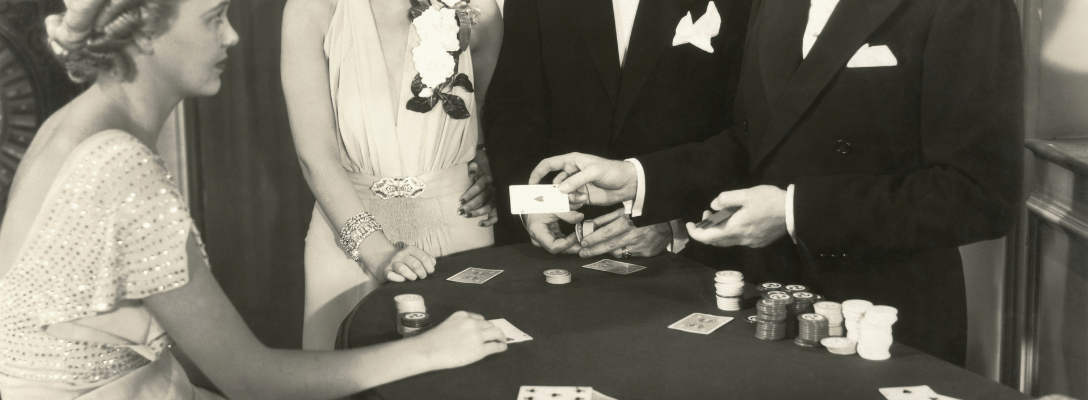
As soon as you hear “Las Vegas,” what’s the first thing you think of? While there are probably a lot of good choices to answer that question, there really is one place most minds go. Yes, of course, the entertainment is a huge draw, and dining has become sublime, but you probably thought about what almost everybody thinks when they talk about Las Vegas: casinos.
The history of Las Vegas casinos goes way, way back. From its humble beginnings as a midway point on an important pioneer trail to its international status as one of the premier entertainment destinations, it’s been a wild ride on its dusty roads. And central to it all is the casino culture, now firmly rooted in the city’s legend for well over a century. But it wasn’t always that way. The path to casino mecca is a tale of iron horses, a town that certainly “gave a damn,” and the infusion of capital from some very unsavory characters. Ready to roll the dice and see what Las Vegas’ casino past really looks like? Take a seat at the table!
While Native American peoples had, from time to time, inhabited the area now known as Las Vegas, there wasn’t always a steady population. Desert living meant an unstable supply of water. But the United States was growing quickly in the late 1800s, and the future city was midway between the developing cities of Los Angeles and Salt Lake City. Ironically, it was Mormon missionaries who first built a major settlement there in 1855. But it didn’t last long as the living conditions were too harsh, and they soon left.
In 1864, the U.S. Army took over and established a fort on the remains of the Mormon building. This stability attracted more folks to pass through and settle in the area. Gold rush prospectors spent time there moving to and from California, using their hard-earned nuggets to fuel early gambling culture. This brought investment and the first hotels and, eventually, a railroad stop. Becoming a railroad town meant more settlers, more folks passing through and more gambling!
By 1905, Las Vegas was officially founded, although it would not be fully incorporated as a city until 1911. But by 1906, the very first casino in Las Vegas opened at Hotel Nevada, now known as Golden Gate. The property’s main focus in 1906 was the modern rooms loaded with amenities rare in those days, including relatively large rooms, electric lighting, ventilation, and heating, but that didn’t stop it from including a casino as well to help entertain weary travelers. It was a touch of elegance for people seeking a first-class experience, and it took off almost immediately.
The Golden Gate was an important fixture as it provided a first in many regards. Besides being the inaugural casino in this now casino-heavy town, it was the first place one could find a telephone in Las Vegas, starting in 1907. By 1927, the town’s very first electrified signage appeared – a harbinger for the massive neon lights and gigantic digital signage of today. Two-way mirrors for monitoring cheating were installed for the first time there, too, back in the 1950s. And in the 1960s, it was the first hangout for the “Rat Pack,” Vegas’s first celebrity gang of Frank Sinatra, Dean Martin, and Sammy Davis, Jr. It’s pretty much all the key iconography of Las Vegas movies and the city itself under one roof!
Amazingly, Las Vegas outlawed gambling in 1910. This had an impact on the city’s economy that would not reverse for decades. However, illicit gambling and even outlawed drinking during the Prohibition era continued. Three things happened in 1931. First, Las Vegas liberalized its divorce laws, drawing unhappy couples seeking easy dissolution. Also, the nearby Hoover Dam’s construction began. Both events drew people into the area, especially dam workers and folks eyeing future development with the promise of a new water source. The third 1931 event: Las Vegas decided to legalize gambling again. Now, the floodgates were opening up!
In the 1940s–1960s, casinos opened by the dozens in Las Vegas. Starting in 1941 with the El Rancho Vegas resort, organized crime figures like Bugsy Siegel poured money into development, establishing what we know today as the Las Vegas Strip. Other iconic casinos followed, such as The Flamingo, The Sahara, and The Sands, all partially or wholly funded by Mob money. With connections to entertainment figures, the Mob’s gambling enterprises expanded to huge live show events, transforming Las Vegas into a multi-faceted draw.
By the 1990s, figures like Steve Wynn began reshaping the Vegas scene with huge modern resorts like the MGM Grand. By the 2000s, Las Vegas had a makeover as a family-friendly spot with all the attractions, shows, food, and fun one could desire. There’s even been an explosion of sportsbooks for sports fans. But for Old Vegas, reverence remained. The Golden Gate Casino was restored to its former old-school glory. Its surrounding area has become The Fremont Street Experience, a pedestrian enclosure with a modern light array and digital displays nestling historic structures like the Golden Gate. The place where Vegas casinos all started now stands at the corner of yesterday and tomorrow!
You can make your own bit of Vegas casino history by stopping by the casino at Golden Gate Las Vegas, now updated with beautiful modern touches, and even enhance it by staying in one of the Original 10 rooms where visitors and gamblers stopped by in 1906. Either stop by the casino, or book a room to fully immerse yourself in Vegas history!